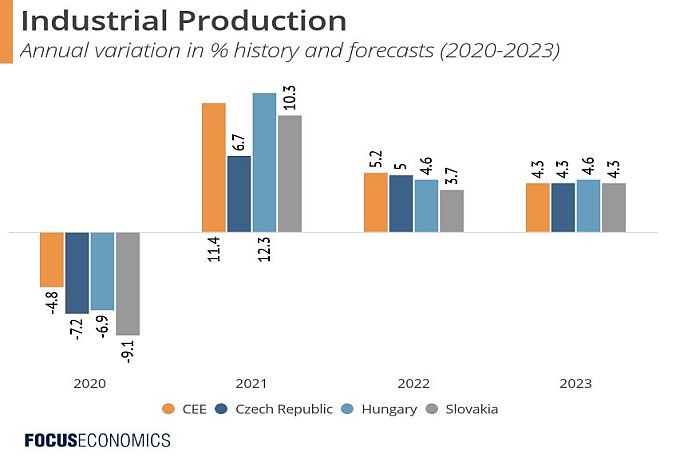By FocusEconomics Insights
ASIA – When it comes to global vehicle production, the top three producers mainly steal the headlines as China, the US and Japan account for over 50 percent of annual output. That being said, the auto industries in the three heavy hitters make up small proportions of their domestic economies. Consequently, the current supply chain issues impacting the auto sector are having much more pronounced impacts in those economies that depend strongly on the auto industry.
Central Europe is home to the Czech Republic, Hungary and Slovakia, where the pre-pandemic values of the motor vehicle manufacturing subsectors accounted for roughly 14 percent, 20 percent and 13 percent of nominal GDP, respectively. Moreover, the industry also provides hundreds of thousands of jobs in the region and plays a vital role in their domestic labor markets. Strong inward investment, cheap and skilled labor, and access to the large EU market has allowed these countries to expand their domestic industries, putting Slovakia and the Czech Republic at the top of the list for vehicles produced per 1,000 people. Nevertheless, the ongoing semiconductor and magnesium shortages, elevated utility costs and heightened commodity prices are wreaking havoc on the car manufacturing sector, which will keep a lid on industrial production growth in 2022.
Going forward, most analysts do not expect the semiconductor shortage to ease until at least 2023 due to capacity constraints. These constraints, given strong demand from other economic sectors and the absence of the massive and timely investment that would be required to ramp up production levels, will limit the amount of chips available for manufacturing for the better part of this year.
That being said, according to the latest IHS Markit Global Sector PMI, some positive signs of rising auto production emerged in the past couple of months and momentum is seemingly gaining traction. Our FocusEconomics Consensus Forecast sees industrial production growth in Central Europe easing from 11.4 percent in 2021 to 5.2 percent in 2022. Our panel of analysts expect sharp slowdowns of growth in Hungary and Slovakia, while growth in the Czech Republic’s industrial sector is seen decelerating slightly.
Don’t miss this new special report on geopolitics in Eastern Europe!
Insights from our analyst network
Commenting on the auto sector’s drag on the Czech economy, Pavel Sobíšek, chief economist at UniCredit Bank, noted:
“By the end of Q3 2021, Czechia had given one of the worst economic performances in the EU since the start of Covid-19, with GDP staying 3.1 percent below the Q4 2019 level. […] A particular problem for Czech manufacturing is its reliance on the automotive sector. The sector remains the worst hit by supply-side disruptions, which come on top of surging prices. Obviously, the situation is causing a disproportionate drag on the economy due to manufacturing accounting for 25 percent of (directly measured) GVA in 2019. The aforementioned headwinds for industrial output could ease in 2022, without fully abating before H2 2022.”
On the global auto sector recovery, analysts at ING noted:
We think that 2022 has a propensity to be a healthier recovery year than 2021, assuming that semiconductor shortages start to subside. At this point, having seen various curveballs during the course of last year, we err on the side of caution and assume that various logistical issues will continue to restrain production at least during the first half of 2022 and, more likely, to a lesser extent, throughout the whole of the year.”
Our latest analysis
What are the Top 5 ways climate change will affect the economy? Find out in this article by economist Matthew Cunningham.
Peru’s cabinet continued to play musical chairs in February. Our economist Stephen Vogado has the details.
The Bank of Mexico opted to hike rates again at its February meeting. Our economist Oliver Reynolds has the latest.





